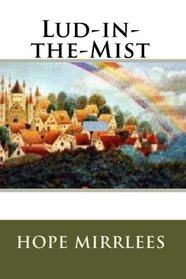Helpful Score: 3
I don't think I'm well-read enough to review this book -- as is the case with many British writers of that period, Mirrlees is far better classically educated than I am, and I'm sure I missed quite a few of her references. However, I now firmly agree with Neil Gaiman that this is "the single most beautiful, solid, unearthly, and unjustifiably forgotten novel of the twentieth century" so I felt I should attempt to review it here in the hopes that I get a few more people to seek it out.
This is most distinctly not the sort of fantasy novel that would be able to get published today. Tolkien's Shire feels strongly influenced by Mirrlees' Lud, but it's not the Shire that so many fantasy writers and publishers have taken as their model, it's all that pesky questing and evil-battling. There are no epic quests in this novel, and there is definitely nothing as comforting as a black-and-white delineation of good and bad.
Instead, Lud-in-the-Mist is somehow at the confluence of high fantasy strongly rooted in folktale and a political thriller. It is written in a surprisingly straightforward, earthy style that nonetheless has plenty of room for some of the most beguiling and delightful descriptive passages I've ever read. It uses broad comedy side by side with the melancholy and the bittersweet. It can be read as a parable of class struggle, or as an endorsement of mind-altering drugs (keep in mind that it was published in 1926, so I highly doubt that this was what Mirrlees intended). It is most certainly about balancing the mundane and the miraculous (paraphrasing Gaiman's introduction), which perhaps explains how it came to be all these things at once.
There are quite a few elements that turned people off (judging from the reviews I've seen online) but every single one of them worked for me: yes, the first third or so was highly episodic; yes, Nathaniel Chanticleer seems a bit of a bumbling fool at first, and isn't exactly likable; yes, it is very British, and quite old, so everyone reads white (though the women come off quite a bit better than in most of the fantasy written by men at the time) and as I mentioned above there are plenty of classical references. If your reading diet is entirely post-Tolkien fantasy, this novel will come as a bit of a shock to the senses. But if you actually enjoyed some of those classics they forced on you in school (things like Gulliver's Travels, for instance, whether you read the satire or not) and want some fantasy with both a brain and a heart, this is absolutely the book for you.
This is most distinctly not the sort of fantasy novel that would be able to get published today. Tolkien's Shire feels strongly influenced by Mirrlees' Lud, but it's not the Shire that so many fantasy writers and publishers have taken as their model, it's all that pesky questing and evil-battling. There are no epic quests in this novel, and there is definitely nothing as comforting as a black-and-white delineation of good and bad.
Instead, Lud-in-the-Mist is somehow at the confluence of high fantasy strongly rooted in folktale and a political thriller. It is written in a surprisingly straightforward, earthy style that nonetheless has plenty of room for some of the most beguiling and delightful descriptive passages I've ever read. It uses broad comedy side by side with the melancholy and the bittersweet. It can be read as a parable of class struggle, or as an endorsement of mind-altering drugs (keep in mind that it was published in 1926, so I highly doubt that this was what Mirrlees intended). It is most certainly about balancing the mundane and the miraculous (paraphrasing Gaiman's introduction), which perhaps explains how it came to be all these things at once.
There are quite a few elements that turned people off (judging from the reviews I've seen online) but every single one of them worked for me: yes, the first third or so was highly episodic; yes, Nathaniel Chanticleer seems a bit of a bumbling fool at first, and isn't exactly likable; yes, it is very British, and quite old, so everyone reads white (though the women come off quite a bit better than in most of the fantasy written by men at the time) and as I mentioned above there are plenty of classical references. If your reading diet is entirely post-Tolkien fantasy, this novel will come as a bit of a shock to the senses. But if you actually enjoyed some of those classics they forced on you in school (things like Gulliver's Travels, for instance, whether you read the satire or not) and want some fantasy with both a brain and a heart, this is absolutely the book for you.
Helpful Score: 2
Written in the 1920's, this book is the contemporary of works such as The Lord of the Rings and it reads somewhat similarly. It often quotes made-up songs and poetry and is given to flights of fancy so far out there that I sometimes found it hard to follow. The basic premise was a good one and I enjoyed the story itself, but the characters were fairly silly and hard to sympathize with. The writing was beautiful and amazingly colorful yet I sometimes had trouble paying attention and comprehending what I was reading. I would often discover when I reached the bottom of a page that I had no idea what had just happened on that page and had to go back to reread. It was hopeless if ever I tried to read this without being able to give it my undivided attention. I liked how the story ended but it seemed a little abrupt. If you're a fun of Tolkein or of Neil Gaiman's Stardust then I'd recommend you give this a try, otherwise probably not.




